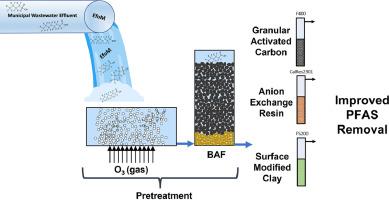Water Research ( IF 12.8 ) Pub Date : 2023-05-24 , DOI: 10.1016/j.watres.2023.120105 Bahareh Tajdini 1 , Hooman Vatankhah 2 , Conner C Murray 3 , Alexander Liethen 1 , Christopher Bellona 1

|
Occurrence of perfluoroalkyl acids (PFAAs) in wastewater effluent coupled with increasingly stringent regulations has increased the need for more effective sorption-based PFAA treatment approaches. This study investigated the impact of ozone (O3)- biologically active filtration (BAF) as integral components of non-reverse osmosis (RO)-based potable reuse treatment trains and as a potential pretreatment option to improve adsorptive PFAA removal from wastewater effluent by nonselective (e.g., granular activated carbon (GAC) and selective (e.g., anionic exchange resins (AER) and surface-modified clay (SMC)) adsorbents. For nonselective GAC, O3 and BAF resulted in similar PFAA removal improvements, while BAF alone performed better than O3 for AER and SMC. O3-BAF in tandem resulted in the highest PFAA removal performance improvement among pretreatments investigated for selective and nonselective adsorbents. Side by side evaluation of the dissolved organic carbon (DOC) breakthrough curves and size exclusion chromatography (SEC) for each pretreatment scenario suggested that despite the higher affinity of selective adsorbents towards PFAAs, the competition between PFAA and effluent organic matter (EfOM) (molecular weights (MWs): 100–1000 Da) negatively impacts the performance of these adsorbents. The SEC results also demonstrated that transformation of hydrophobic EfOM to more hydrophilic molecules during O3 and biotransformation of EfOM during BAF were the dominant mechanisms responsible for alleviating the competition between PFAA and EfOM, resulting in PFAA removal improvement.
中文翻译:

废水有机物对颗粒活性炭和替代吸附剂从废水中去除全氟烷基酸的影响
废水中存在全氟烷基酸 (PFAA),再加上日益严格的法规,增加了对更有效的基于吸附的 PFAA 处理方法的需求。本研究调查了臭氧 (O 3 ) - 生物活性过滤 (BAF) 作为基于非反渗透 (RO) 的饮用水回用处理系统的组成部分的影响,以及作为一种潜在的预处理选项,通过以下方法改善废水中吸附性 PFAA 的去除:非选择性(例如颗粒活性炭 (GAC))和选择性(例如阴离子交换树脂 (AER) 和表面改性粘土 (SMC))吸附剂。对于非选择性 GAC,O 3 和 BAF 产生类似的 PFAA 去除效果,而单独使用BAF对于 AER 和 SMC, O 3 -BAF的性能优于 O 3。在选择性和非选择性吸附剂研究的预处理中,O 3 -BAF 串联产生了最高的 PFAA 去除性能改进。溶解有机碳 (DOC) 突破曲线和尺寸排除的并行评估每种预处理方案的色谱 (SEC) 表明,尽管选择性吸附剂对 PFAA 具有更高的亲和力,但 PFAA 和出水有机物 (EfOM)(分子量 (MW):100–1000 Da)之间的竞争会对这些吸附剂的性能产生负面影响。SEC 结果还表明,O 3过程中疏水性 EfOM 转化为更亲水的分子以及 BAF 过程中 EfOM 的生物转化是缓解 PFAA 和 EfOM 之间竞争的主要机制,从而提高 PFAA 去除率。


























 京公网安备 11010802027423号
京公网安备 11010802027423号